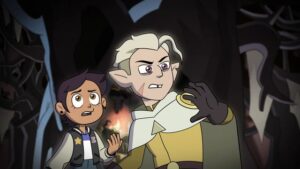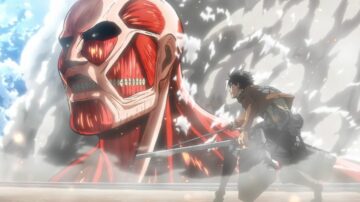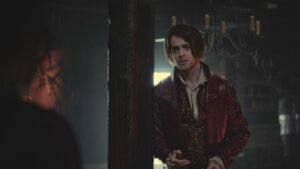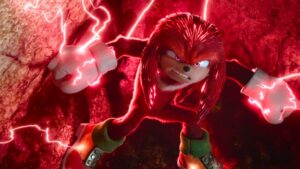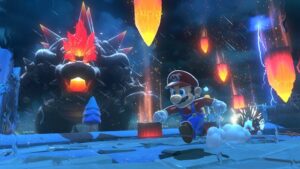The original Cowboy Bebop anime was a story about the ways in which the past haunts the present, or to quote former Kotaku writer Richard Eisenbeis’ 2014 article, “the epilogue to a story we never get to see.” While the audience sees glimpses of Spike’s former life as a member of the Red Dragon syndicate, his love affair with Vicious’ girlfriend Julia, and his near-fatal departure from the syndicate throughout the series, the full story of who Spike was and how his life took such a near-fatal turn is never seen or explained.
Netflix’s Cowboy Bebop takes a different approach. Of the many ways the live-action series diverges from the original series, none are perhaps more dramatic or consequential than episode 9, “Blue Crow Waltz,” which offers a glimpse into Spike’s previous life as “Fearless,” a hitman for the Syndicate, and the events which lead up to his presumed death at the hands of his former partner Vicious (Alex Hassel).
[Ed. note: The rest of this article contains spoilers for the ending of Cowboy Bebop.]
For Bebop showrunner André Nemec, unfurling the history within the new continuity of the series was pivotal. “It was a story that we had to tell ourselves in the writers room, in order to really understand the character of Vicious; who he is, what he is, and why he is,” Nemec tells Polygon. “It felt critical that we should just tell that story, like, that is the foundation by which we are building this entire season. This is the event that sets everything in motion.”

Set three years before the present-day events of Cowboy Bebop, “Blue Crow Waltz” shows what led to Vicious and Fearless’ fallout — namely a bloody gang war. What Vicious starts, Spike cleans up, and Spike’s tryst with Julia behind Vicious’ back is the final fracture. But more than simply being a story about a passionate feud between two men, the episode is an origin story for Julia, Spike’s former flame and a character who was never fully explored in the original anime. “In the original idea of the breaking of episode 9, I had always looked at it as Julia’s episode,” Nemec says. “I thought it was important that the character be the architect of her own journey, rather than a dramatic tool to tell a story between these two guys.
“To me, it was important that she was whole and fleshed out as a person, but not just as a victim under the thumb of Vicious — which is a place that I knew we wanted her at the beginning of this story — but also to give her the agency of crafting her path out […] The spirit of it definitely came from: I want to know more about Julia. Like, who is this Helen of Troy?”
For Elena Satine, the challenge and opportunity of portraying this evolution was in creating the distinction of who her character was in relation to other characters versus who she was to herself. “I approached Julia as two different characters, essentially, there was the idea of Julia that is perpetuated by Spike and his memories of Julia. But then there’s the real Julia, which in the anime, we briefly see running around with a gun shooting people. She’s not exactly the same girl as the one that is in his memories, so that was sort of a starting off point for me approaching the character. And I kind of went from there and built on that and the slow morphing of Julia from someone else’s dream girl to this woman who’s very much at the end, you know, in control of her own destiny.”

To say that Julia in the live-action Cowboy Bebop feels completely different than the character glimpsed in the original anime is an understatement. In truth, Julia wasn’t much of a character so much as she was an idea in 1995’s Cowboy Bebop. At first seen as a terrified, albeit willing, wife to Vicious, Satine’s portrayal gradually evolves beyond her initial appearance, eventually wresting control over the syndicate from her husband and rebuking Spike in her own ascent to power. After shooting Spike and imprisoning Vicious, it’s Julia who wields the most power at the end of season 1. “I knew at the beginning that I wanted this to be the birth of a villain,” Nemec says. “I thought we had an incredible opportunity to tell the story of someone who really is caged, who finds empowerment, and we look at her and we’re just kind of like, Ooh, she’s dangerous, like she’s properly dangerous — and I think she is by the final frames of season one.”
By not only showing Julia’s backstory, but reframing her arc as a sympathetic, empowered, and ruthless antagonist, Cowboy Bebop ventures into unprecedented narrative territory that the anime never broached. Where the Netflix series might take her story going forward is unknown for now, but if there’s anything certain about who Julia is now versus the character in the anime, it’s this: she’s more than just someone’s dream girl.
Source: https://www.polygon.com/22789697/cowboy-bebop-julia-episode-9-flashback
- 9
- alex
- anime
- around
- article
- audience
- Biggest
- Building
- challenge
- Creating
- Dragon
- Event
- events
- evolution
- fallout
- finds
- First
- Forward
- Foundation
- full
- Gang
- history
- How
- HTTPS
- i
- idea
- important
- IT
- journey
- lead
- Led
- looked
- love
- Men
- namely
- Netflix
- Offers
- Opportunity
- order
- Other
- partner
- People
- pivotal
- Polygon
- power
- present
- REST
- running
- sees
- Series
- So
- tells
- The
- Ventures
- Versus
- war
- What
- WHO
- within
- woman
- writer
- years

